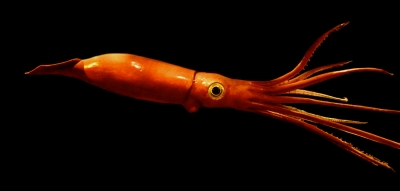
The oesophagus of the colossal squid leads from the beak into the stomach and caecum, where food is digested. It’s only about 10 mm in diameter and passes through the middle of the squid’s doughnut-shaped brain. The colossal squid has to cut up food into small chunks so it can pass through the narrow oesophagus.
The squid’s stomach is a small, shiny white sac that connects to the stomach pouch or caecum. Digestion of food begins in the stomach. The caecum also performs some digestion and is the primary site of absorption of nutrients. Enzymes from the liver and pancreas help digestion.
Waste passes into the intestine, a narrow tube adjacent to the stomach pouch, then empties into the rectum. The end of the digestive system is the anus, from which waste exits into the funnel.
Squid and octopus have an intricate nervous system, more complex than other molluscs, and invertebrates in general.
The squid brain is enclosed in a cartilaginous head capsule and includes two large optic lobes. These indicate that vision is very important to squid. Up to 80 per cent of the brain is devoted to processing visual information.
The brain is shaped like a doughnut and surrounds the narrow oesophagus. It is very small in comparison with the overall size of the body — a 300 kilogramme colossal squid has a brain weighing less than 100 grammes!
Credit : Te Papa
Picture Credit : Google




